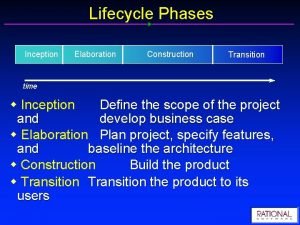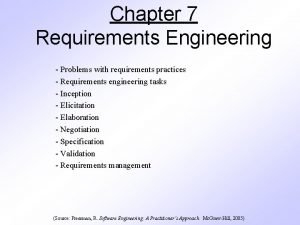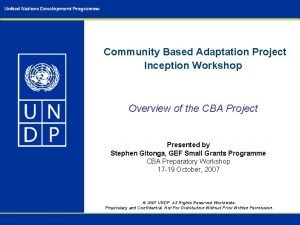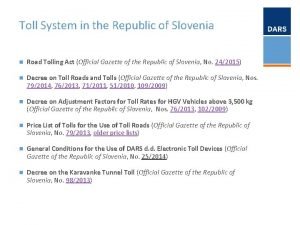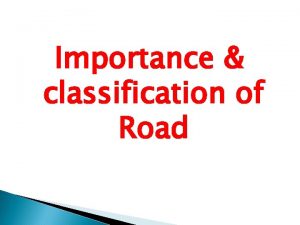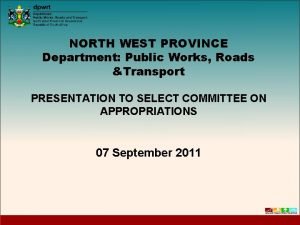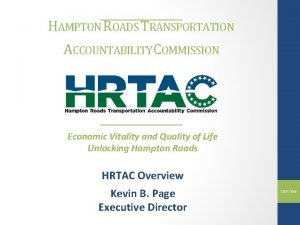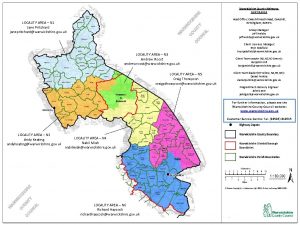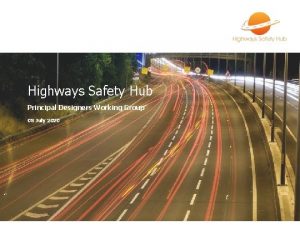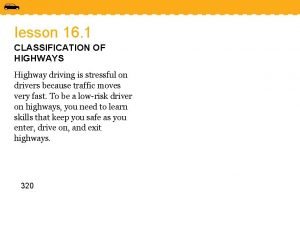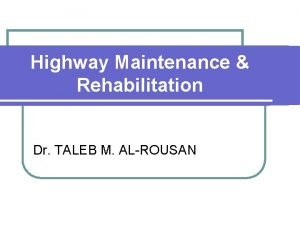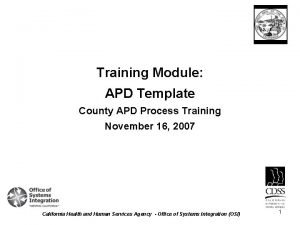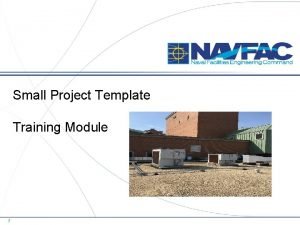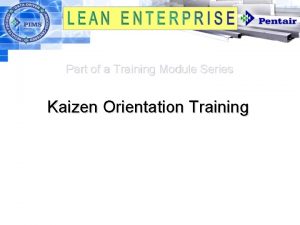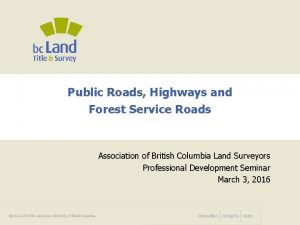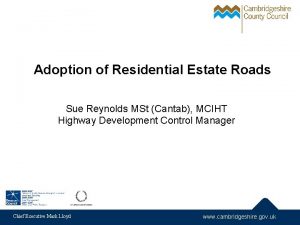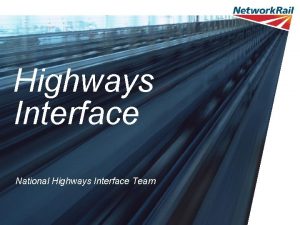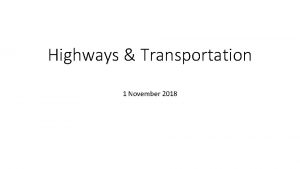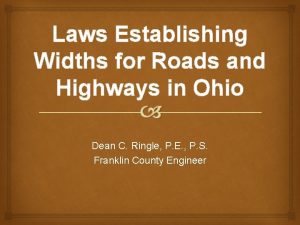Highways Training Module Residential Estate Roads From Inception





































































- Slides: 69

Highways Training Module Residential Estate Roads – From Inception to Adoption

Areas Covered in the Complete Module H 1 - Land acquisition considerations H 2 - Planning process H 3 - Relevant legislation H 4 - S 278 Agreements H 5 - Surface water drainage/run-off including Su. DS infrastructure H 6 - S 38 Design, approval, surety considerations and adoption of highway infrastructure H 7 - Commuted sum payments – negotiations and outcomes H 8 - Construction and inspection H 9 - Alternative adoption/maintenance options and arrangements H 10 - Provision of street naming and numbering H 11 - Commercial considerations

Highways training module – Glossary of Abbreviations APC – Advance Payments Code (Highways Act 1980) BRE – Building Research Establishment CBR – California Bearing Ratio (Soil strength parameter) CDM – Construction Design & Management Regulations (2015) Df. T - Department for Transport HA - Highway Authority JR - Judicial Review LLFA – Lead Local Flood Authority MCHW – Manual of Contract Documents for Highway Works NHBC - National House Building Council NPPF – National Planning Policy Framework PFI – Private Finance Initiative RPI – Retail Price Index So. S – Secretary of State (Department for Transport) Su. DS – Sustainable Drainage Systems TA – Transport Assessment TCPA – Town & Country Planning Act 1990 as amended

Highways training module START OF MODULE H 1

H 1 - Land acquisition considerations Ground Conditions Drainage Planning Status External Works Utility Services Highways NB - Site Remediation Strategy – can affect all aspects Legal Issues

H 1 - Land acquisition: essential highway considerations • Is access to the site readily available, i. e. no intervening third party land affecting highway access and/or sightlines? • Is the site under consideration to be purchased freehold or leasehold? (This can affect the house builders ability to enter into a S 38 highway adoption agreement). • Is there a need for a Transport Assessment (TA)? – see note 2. • Are off-site highway improvements required – S 278 works? – see note 3. • S 278 design – who undertakes this part of the design? Consider also surety/bonding requirements and potential compensation claims from existing residents. • Sight-line requirements – are these defined? Can they be achieved? Are there any obstructions affecting the sight-line? • Are there any existing rights of way and/or public footpaths/bridleways affecting the site? See note 5. • What are the Highway Authority’s design standards, i. e. highway geometry & construction specification. • Ground conditions and likely CBR values – these are key consideration – see note 4. • How will drainage be dealt with - permeable paving, swales etc or a piped system or combination of various options? • Commuted sum payments – what is the Highway Authority policy? • Are any highway retaining walls or other retaining structures likely to be required?

H 1 – Land acquisition: Freehold or Leasehold land purchase? This is an important question. • The Highways Act 1980 implies that only the land owner can enter into a Section 38 Highway Adoption Agreement. • Leasehold arrangements for land acquisition can present house builders with a problem in that the Highway Authority may not be willing to enter into an agreement unless the house builder, as leaseholder and the actual land owner are a party to the agreement. • In such circumstances, land owners who are not house builders may be unwilling to enter into the agreement and they cannot be forced to do so. • House builders should check with the Highway Authority to determine if a leasehold arrangement will be sufficient collateral to enter into a S 38 agreement. • The remaining period of the lease will be another important consideration as certain Highway Authorities may set a minimum residual leasehold period, e. g. nothing less than say 99 years.

H 1 – Land acquisition: Transport Assessments (TA) • In any early discussions the Highway Authority should be able to confirm whether or not a TA is required as part of the planning application. It is normal for house builders and developers to retain external Highway Engineering Consultants for undertaking Transport Assessments. • The outcome of the TA will determine what, if any, off-site highway improvements may be required – these works will usually be undertaken on behalf of the Highway Authority through a dedicated Section 278 Agreement – for more detail see Module H 4. • Any off-site highway improvements works that may be required will need to be included as an integral part of the planning application together with an appropriate reference in any Design & Access Statement that may be required by the Planning Authority – see Module H 4.

H 1 – Land acquisition: Highway Design Standards Minimum information requirements 1. Determine what design specification the Highway Authority (HA) will impose, for example, Manual for Streets or the HA’s own standards. 2. Obtain a copy of the Highway Authority’s Design & Construction specification – this may also include information checklists to assist when submitting a highway design for Section 38 Technical Approval. Will the MCHW requirements be applied to any part of the works? 3. Check with the Lighting Authority regarding their requirements – it may not be the Highway Authority that deals with street lighting – see the general notes below. 4. Check sight-line requirements and ensure that both the site access junction and sight-lines are not impacted by third party land and/or obstructions, in particular trees with preservation orders in place or property boundary walls. 5. Try and determine what inspection fees will be required by the HA 6. Check with the HA to determine if they have any local requirements or policies regarding particular materials, including the use of recycled aggregates in parts of the road construction, typically capping layers and/or unbound granular sub-bases. This also applies if geotextiles will likely form part of the intended highway construction.

H 1 – Land acquisition: Ground Conditions/CBR values • This is an important consideration as it will determine the structural design of the highway. • This information should be an integral part of the output from the ground/site investigation undertaken for the site. In addition, targeted ground investigation will also help to determine if Su. DS infiltration drainage solutions for highway drainage will be possible/practical – see general notes. • If no ground/geotechnical information is available then a 2% CBR could be assumed for initial costing purposes with the land purchase contract potentially conditioned accordingly, e. g. subject to satisfactory ground conditions/CBR test results. • The outcome of the ground investigation could recommend that geotextiles may be an option for dealing with soils of low bearing capacity that may be encountered at road formation/foundation level. This is an acceptable engineering solution but the views of the Highway Authority on the use of geotextiles should be sought at the outset – highway authorities can have genuine concerns about the use of geotextiles and what they are prepared to accept as alternative forms of construction, which in turn can be expensive. It is always prudent to engage with the HA on such matters – see note 2. • Whilst relatively rare these days, poor ground conditions can be improved by lime/cement stabilisation – if this is being contemplated, it will require careful consideration.

H 1 – Land acquisition: Highway Drainage • What are the highway drainage proposals recommended in the site specific flood risk assessment? • Will highway drainage be incorporated into the surface water drainage strategy for the site has a whole? • What is being proposed – permeable paving, swales, attenuation ponds, piped system? • What is the Water & Sewerage Company’s attitude towards acceptance of highway drainage in S 104 adoptable sewers? • Are ground conditions suitable for infiltration drainage solutions/permeable paving? • Consider the cost of additional excavation arisings if above ground drainage infrastructure is proposed/required.

H 1 – Land acquisition: Commuted Sum Payments • It is essential for house builders to check and verify what, if any, commuted sums for the future maintenance of certain highway infrastructure will be required – note some of the contributions demanded can be substantial. • The Highway Authority should not only be asked to disclose any schedules that they have relating to possible commuted sum payments but they should also be asked to provide definitive evidence demonstrating how they have been determined. • Any payments that are made should be ring-fenced for their intended purpose and not included in a Highway Authority’s general income.

H 1 – Land acquisition: CPD Questions 1. Can you name at least 4 of the principal aspects that can have a direct impact on highway matters? 2. What is a TA and what is its purpose? 3. Name at least 3 options for dealing with highway drainage 4. From a highways perspective what importance is attached to land acquisitions involving freehold or leasehold arrangements? 5. What are the implications for house builders if they do not have a controlling legal interest in all land necessary to secure access? 6. What are CBR values? 7. What is a site specific flood risk assessment and can this have an impact on highway design considerations?

H 2 – Highways and the planning process START OF MODULE H 2

H 2 – Highways & the planning process • Prior to making a planning application, house builders and developers are actively encouraged to enter into pre-application discussions with the Highway Authority, Planning Authority, Lead Local Flood Authority and Sewerage Company, ideally with all parties represented at each and every meeting. • With the exception of the Sewerage Company, all other parties are statutory consultees for almost all planning applications. • At the pre-application discussion/meeting stage the Highway Authority may need to be ‘pushed’ to confirm that the on-site road geometry proposed as part of the planning application (detailed/reserved matters) is acceptable and will not be subject to further revision as part of the S 38 technical approval process. • This meeting is also crucial in terms of crystallising the extent of any off-site works as defined at the land acquisition due diligence stage. • Whether a Design & Access Statement is required will need to be known. If yes, then the content and structure thereof will need to be agreed with both the Highway Authority and local Planning Authority

H 2 – Highways & the planning process Planning stage – technical submissions (Outline Planning) • When making an outline planning application the design of on-site highways normally becomes a reserved matter to be dealt with by way of dedicated planning conditions. • At this stage there may be a necessity to submit a Transport Assessment (TA) as part of an outline planning application. On some occasions, the Local Planning Authority may also seek an accompanying traffic noise survey/assessment. • Off-site highway improvements and the main access arrangements to a site may also be a requirement, sometimes necessitating detailed design as part of the outline application. • What is important at this stage is for any application to comprehensively deal with the requirements of the highway authority and planning authority respectively. • New development can be challenging for existing communities to accept and therefore a complete and comprehensive planning submission, including Transport Assessments are key to demonstrating that the impacts of a development have been appropriately assessed and mitigated.

H 2 – Highways & the planning process Planning stage – full or reserved matters application • In the case of a full planning application, this will require the submission of detailed design proposals for all on-site highway works and any off-site highway works that may be required. • Detailed designs may also be required when submitting a reserved matters application in response to highway matters that remain to be dealt with by way of related planning conditions. • Site levels and gradients of roads, drainage and landscaped areas, (the important third dimension) can also have an important impact on the design of residential estate roads, for example: a) The need for highway retaining walls b) Highway gradients and the maximum gradient allowed, including those at junction approach ‘platforms’. Minimum gradients can also be an issue as flat roads can create drainage issues. c) The need to consider driveway gradients to avoid ‘grounding’ the underside of vehicles entering a driveway d) Principal drainage considerations

H 2 Highways & the planning process All planning stages – important considerations • To avoid delay and to ensure that a correct planning decision notice is issued, it is important that the red and blue edgings on the application plan reflect either the full extent of the land owned or land over which the applicant has a controlling legal interest – see note 1. • Highway issues, in particular off-site works under S 278, can present their own problems as well as being a source for delay in the approval process. For example, the Highway Authority may not necessarily accept the construction of off-site works within an existing public highway based solely on entering into a S 278 Agreement. Some Highway Authorities insist that S 278 works also have to have planning consent - see note 2. • If a Safety Audit is to accompany the planning application make sure this is in the format the Highway Authority requires and that it contains all necessary information that is required. • As part of the pre-application discussions involving the Highway Authority there is always merit in asking the Authority if they have a generic, draft S 38 Agreement that can be taken away for due consideration – see note 3.

H 3 - Relevant legislation START OF MODULE H 3

H 3 – Relevant legislation This part of the module has been deliberately restricted to cover the main legislation and statutes that presently underpin the design, construction and adoption of residential estate roads. The first attempt at introducing highway legislation came into being with the introduction of the Highways Act of 1555 - this defined who was responsible for ongoing maintenance of what was then considered to be a public highway. In 1835 mechanisms for the creation and ‘adoption’ of new highways came into force as a result of the Highways Act 1835. But it was not until the introduction of the 1959 Highways Act that legislation regarding roads in general was finally consolidated. Much of this has earlier legislation has been carried forward to the Highways Act 1980 – it is still in force today, influenced by case law and precedent. Importantly, house builders have to work in a highway-related environment that is not always clear cut. Whilst many would say that a comprehensive review and update of current highway legislation is long overdue in the present Parliamentary timetable this is highly unlikely.

H 3 - Relevant legislation Active legislation influencing highway matters – see note 1 • Town & Country Planning Act 1990 (as Amended) • National Planning Policy Framework (NPPF) • Community Infrastructure Level Regulations 2010 • Housing & Planning Act 2016 & Transport Assessments – see note 2 • Highways Act 1980 • Land Compensation Act 1973 – see module covering S 278 Agreements • Noise Insulation Regulations 1975 • Traffic Management Act 2004 • New Roads & Streetworks Act 1991 (As Amended) • Road/Speed Humps legislation – The Highways (Road Humps) Regulations 1999 Statutory Instrument 1999 No. 1025

Modules H 2 & H 3 – CPD questions 1. Name at least 2 important regulatory bodies that should attend any pre=planning application engagement meetings. 2. State at least 3 important strands of evidence/information to secure at these meetings. 3. Why is it important to secure Highway Authority approval to the road layout and geometry at the planning stage? 4. What is a Design & Access Statement? 5. What is the importance of a transport assessment?

H 4 – Section 278 Agreements START OF MODULE H 4

H 4 – Section 278 Agreements This remains a fundamentally important part of the development process given that the procedural aspects are often of equal importance to the design and construction of any off-site highway works – see note 1. It is quite common to find the requirement to construct off-site highway improvements under the provisions of S 278 is also linked to a S 106 Planning Agreement. This can be in addition to dedicated highway planning conditions. The process for designing and approving off-site highway works needs careful consideration – a failure to follow the Highway Authority’s direction and/or requirements can result in significant delays (and additional costs) when seeking both technical approval from the Highway Authority, together with completion of the actual agreement. For those off-site highway improvements involving Highways England – see notes 2 and 3 – the process and commercial/cost implications can be significant and therefore need careful consideration.

H 4 – S 278 Agreements: Typical terms & conditions • Reference should be made to the relevant planning permission and/or authorisation under which the works are to be carried out – see note 1 • A schedule of works including drawings/details should be clearly defined • The extent of the works and what land may need to be dedicated as highway needs to be clearly identified. It is not unusual for some Highway Authorities, including Highways England to require the transfer of such land – this can create difficulties if the house builder does not have title to such. • The amount of bond or surety should be clearly stated and reflect of the reasonable cost of the works – see note 5. • Details of commuted sum payments for future maintenance should be defined. • Agreement on who is to design the works and who will undertake the supervision and verification thereof needs to be defined. The house builder’s retained consultant and contractor must be acceptable to the Highway Authority – usually evidenced by being on the HA’s ‘approved list’. • The cost of any design approval fees and/or supervision fees that may be payable to the Highway Authority must again be defined – see note 4 • Details of the full costs of the works to be paid for by the house builder/developer are to be defined – see also note 2. • Any additional costs that may be payable, for example, any costs associated with the Land Compensation Act 1973 – see notes 2 and 3 should again be defined.

H 4 - S 278 Agreements Information to be provided by the House Builder/Developer This presumes the house builder/developer, their retained consultants and preferred contractor respectively are allowed to undertake all aspects of the works – see notes 1 and 2 • Name/address of Solicitor acting on behalf of the house builder/developer • Confirmation as to who will be providing any bond or surety • Name/address of the proposed contractor, including but not limited to: 1. Appropriate references 2. Insurances 3. Certificates to work in the public highway 4. Confined spaces certification 5. Health & Safety Plan/method statement(s) 6. Details of site specific temporary traffic management arrangements 7. Land ownership details/filed plan 8. Expected duration of the works and emergency contact details

H 4 - S 278 Agreements: Other considerations • Some Highway Authorities have been known to require simple junction construction or even vehicle crossings to new dwellings that are accessed off an existing public highway to be the subject of a S 278 Agreement. This is may appear to be an inappropriate use of S 278 and alternative mechanisms should be explored – see below. • Section 184 of the Highways Act 1980 is a far more appropriate mechanism for dealing with the construction of vehicle crossings to existing public roads. However, the scope of this strand of legislation is limited as other footpath works and bell-mouth construction would not necessarily be covered – see note 2. • The construction of a simple junction from an existing public highway to provide highway access to a new site can be covered by a S 38 Agreement with ‘Accommodation Works’ which effectively include S 278 clauses within a single combined agreement – see note 1. • If confronted with demands to enter into a S 278 agreement for anything other than off-site highway works these demands should be challenged – see note 1.

H 5 – Highway drainage including Su. DS START OF MODULE H 5

H 5 – Highway drainage including Su. DS Initial considerations How we effectively deal with highway drainage is becoming more of an issue than at any time in the past, with certain Water & Sewerage Companies becoming more reluctant to accept highway drainage into S 104 adoptable surface water sewers and/or other surface water drainage infrastructure that they may control – see note 1. An increasing number of highway authorities are also insisting that prior to formal adoption of any newly constructed residential estate roads, the underlying sewers must be first adopted by the Sewerage Authority – there is nothing in the Highways Act 1980 that imposes such a requirement and it can be challenged, although it should be recognised why a highway authority would ask for such a requirement – see earlier parts of the module regarding protecting the public interest – also see note 3. Section 100 of the Highways Act provides some clarity when it comes to the destination of highway drainage, namely, that it does not necessarily have to discharge to a public or adoptable surface water sewer – see sections 100 (1) and (9) of the ‘Act’ – see also note 2.

H 5 – Highway drainage including Su. DS • The need for sustainable drainage solutions on almost all sites has been part of the development process for several years, evidenced by the continued growth in ‘non-piped’ systems to deal with highway drainage. The most common of these being permeable paving followed by soakaways, swales and infiltration drainage cells. • The key to effective delivery of any or all of these drainage options relies upon a robust and informed understanding of site characteristics, in particular ground conditions. The permeability of the underlying rocks and soils being one of the most critical considerations – see module H 6. • The attitude of the Highway Authority when it comes to adoption, in particular the terms and conditions that are imposed as part of the adoption process are also matters of considerable interest. It is recommended that these important considerations are discussed and agreed with the Highway Authority, and if at all possible, as part of the initial due diligence process – see notes 1 and 2. • As highway drainage solutions may also have to be agreed with the Lead Local Flood Authority (LLFA) as part of the surface water drainage strategy for a site and as part of the planning process, it is important for any preapplication discussions to include the LLFA , Highway Authority and if at all possible, the incumbent Water and Sewerage Company.

H 5 Highway drainage & Su. DS – Other considerations • There is widespread use of permeable paving in highway and parking area construction. It is often specified in tandem with underlying geo-cellular ‘storage’ crates (see illustration opposite) in response to a calculated surface water storage volume. • There a number of key issues that must be considered when specifying such options and which in turn will inform the design process – see also notes 1, 2 and 3: ØUnderlying ground conditions, namely, soil type, bearing capacity, soil permeability, groundwater level, including the prospect of seasonal groundwater variations ØThe ability of the geo-cell to accommodate traffic loadings ØHow surface water discharging from the geo-cell is to be dealt with in terms of the next stage in the destination of surface water run-off. ØThe cost of disposing additional excavation arisings – often destined for a licensed landfill. ØIf infiltration is being considered then check to see if the site is located in a groundwater source protection zone (SPZ) as defined by the Environment Agency. ØFuture maintenance considerations – may be linked to planning conditions ØImpact of utility services, i. e. during their provision, future access for subsequent maintenance and repair and reinstatement of the road.

H 4 and H 5 – CPD Questions 1. Name 3 highway drainage options 2. What should S 278 Agreements not cover? 3. What role does Highways England play in S 278 Agreements? 4. Why is it important to have an understanding of the prevailing groundwater regime when proposing Su. DS as part of the highway construction/drainage? 5. Why do Highway Authorities retain so much control over off-site S 278 works?

H 6 - Section 38 Design, Technical Approval, Bonding & Adoption START OF MODULE H 6

H 6 - Section 38 Design, Approval, Bonding & Adoption • This module represents a key milestone in the design and technical approval for those residential roads that are to be adopted under Section 38 of the Highways Act 1980. It is at this stage when the qualitative and quantitative aspects of the information gathered at both the technical due diligence stage and pre-planning stages respectively are put to the test. • The module assumes that planning consent for a new housing project has either just been granted, or there is a degree of certainty that a positive and acceptable planning decision will be forthcoming – see notes 1 and 2. • At the design stage bonding arrangements can also be established in principle. Most house builders will opt for either NHBC or Premier Guarantee to provide the necessary surety and as such early engagement with either organisation can greatly assist – see note 3. • The S 38 process is relatively straight forward, however it is not uncommon to find resource limitations within Highway Authorities are a serious constraint to seeking the earliest possible technical approval and subsequent completion of a S 38 Agreement.

H 6 - Section 38 Design Important design considerations: 1. 2. 3. 4. 5. Ensure you have the latest edition of the Highway Authority’s design and construction specification. Similarly, any process guidance dealing with the submission and approval process. Ensure that any changes to the geometric layout of the roads are nominal – this is where the importance of ensuring the layout approved at the planning stage is supported by the Highway Authority if delays and/or a return to the planning process is to be avoided. Ensure sufficient geotechnical information exists to complete the structural design of all adoptable roads, structures (retaining walls), earthworks, culverts and bridges. Representative CBR values are crucial at this stage in the process but see note 1. Street Lighting Design – where lighting is to be provided and subject to confirmation of the Lighting Authority, which may not necessarily be the Highway Authority as noted earlier, some Lighting Authorities may insist on designing the lighting scheme themselves. Once a road layout is approved at the planning stage, there is merit in commissioning the design in accordance with the Highway/Lighting Authority’s specification – see note 2.

H 6 - Section 38 Design Approval • Normally, this should be a matter of routine but a lack of resources within a number of Highway Authorities often impedes progress. Similarly, not following the HAs technical information requirements, their processes or by making incomplete submissions – see note 2. • If the S 38 design is commissioned from external consultants, then it make it clear in the brief to the consultant that: 1. They are responsible for securing the earliest possible technical approval but not at any price 2. That in the event that the Highway Authority requires anything other than nominal changes to the submitted design then any major changes must be first agreed with the Client House Builder. • Simultaneous with the design approval can be instructions to the house builder’s solicitor to review any draft versions of the S 38 Agreement. Note that many Highway Authorities will work sequentially and will wait until the technical approval stage before instructing solicitors to draw up a Section 38 agreement. • Once design approval is secured, consent to start on site at the earliest practical opportunity should be sought, but this is not without its limitations - see note 1.

H 6 – Advance Payments Code • The Advance Payments Code is key part of the Highways Act 1980 and linked to the Building Regulation process. It enables the Highway Authority to secure an appropriate sum for the completion of the roads within a development so that if they are approached by residents at a later date under the Private Street Works Code such sums can be used to make up the road to adoptable standards rather than charge residents for the privilege. • The system is enshrined in primary legislation and Highway Authorities are obligated to follow it. Failure to pay a sum secured by such a Notice (Under S 220 of the Highways Act 1980) is an offence. It also has the potential to have an impact on house sales. • However, not all Highway Authorities serve APCs so there is a need to check with the Highway Authority regarding their regime. • It should be noted that the sums are payable only when works on the buildings themselves actually start, usually when starting foundation construction. Therefore, it is possible to build the entire road system and not pay the sum but start a foundation and the house builder becomes liable for that dwellings proportion. • While a Highway Authority can require a cash deposit, most now accept a financial security or bond in lieu thereof.

H 6 - Section 38/APC Bonding Arrangements & Inspection Fees • Surety (bonding) options tend to fall to one of two organisations, namely, NHBC or Premier Guarantee, with little difference in terms and conditions between the two organisations. • The process leading to the securing of a bond is usually as follows: 1. Following a Full Pans Submission or the serving of an Initial Notice under the Building Regulations, the Highway Authority has a maximum period of 6 weeks to issue an APC Notice under Section 220 of the Highways Act 1980. 2. The S 220 Notice confirms the estimated cost of the Highway Works, as determined by the Highway Authority, in order to bring roads up to a standard suitable for adoption. This figure is often reflected in the S 38 agreement in terms of defining the required level of bond. 3. The bonding amount can also include a sum to cover the cost of any commuted sum payments that may be demanded as part of the S 38 Agreement. 4. Most Highway Authorities set their inspection fees as a percentage of the S 38 bond value.

H 6 - Section 38 Adoption • One of the principal requirements for adoption under S 38 is that any newly constructed roads must ultimately connect direct with a public highway maintainable at the public expense. If this requirement is not met there is a high probability that all roads will remain private. • As mentioned in earlier parts of this module, whether the land on which any new roads are to be constructed is held by either a freehold or leasehold interest is crucial. The normal requirement for roads to be adopted under S 38 is that the house builder must have a freehold interest. • If a leasehold arrangement is in place, then discussions with the Highway Authority become of paramount importance in terms of their accepting a long term (say 99 years) leasehold interest – see note 1. • The S 38 Agreement will define at what stage the pre-adoption maintenance period commences and what reductions in bond may apply. Similarly, the conditions that will need to be satisfied to proceed to formal adoption and cancellation of any bond – see note 2. • It is not uncommon that having set a timescale for final completion of any new roads and footpaths, the Highway Authority will seek to introduce provisions within the S 38 Agreement that allow for increases in inspection fees and bonding requirements in the event that delays in completing the works arise. This needs careful monitoring including co-ordination with other elements, typically, street lighting and drainage – see notes 3 and 4.

H 6 - Section 38 Design, Approval, Bonding & Adoption CPD Questions 1. Name two principal requirements for adoption under S 38? 2. Why is it considered important to have a settled/agreed highway layout at the planning stage? 3. What are the key issues to watch out for in the terms & conditions of any S 38 Agreement? 4. What is the import difference between a freehold and leasehold land interest? 5. What is the Advance Payments Code and what is it intended to cover? 6. What period of time does a Highway Authority have in which to serve a statutory Section 220 APC Notice?

H 7 Commuted sum payments - how they can be challenged START OF MODULE H 7

H 7 Commuted sum payments - how they can be challenged • In October 2014 the questionable legitimacy of commuted sum payments, levied under the provisions of S 38 (6) of the Highways Act 1980, was finally tested in the Courts. Unfortunately for house builders, the decision handed down by the Court of Appeal effectively confirmed the legitimacy of commuted sum payments – see Redrow Vs Knowsley Borough Council - 31 st October 2014. Prior to this decision, the imposition of commuted sum payments for future highway maintenance had rarely featured, albeit some Highway Authorities believed commuted sum payments for the maintenance of certain types of highway Su. DS infrastructure were appropriate – see note 1. • In many respects, quantum associated with these payments has never been tested in the Courts and it remains a source of continued concern for house builders. Consequently, it remains a key area of legitimate challenge when commuted sums are being imposed by Highway Authorities - see other sections of this module. • Any commuted sum that is deemed appropriate must be clearly defined and allocated for the intended purpose. Moreover, it has long been held that commuted sum payments can only apply to those parts of the highway construction that are deemed outside of what a Highway Authority considers to be its normal specification – see note 2.

H 7 Commuted sum payments – what to challenge The areas for challenge fall into a number of areas/categories: 1. The first question is whether parts of the intended/approved construction are deemed out of specification and if so on what basis? – see note 1. 2. How the commuted sum has been determined is the next question – see note 2. 3. The duration (maintenance period) over which the commuted sum relates must be clearly identified. The design life used in most highway designs for lightly trafficked residential roads is normally 40 years – no commuted sum payment should ever be based on a period in excess of the design life of highway infrastructure. 4. Street lighting can be an area where excessive commuted sum payments are demanded but by way of a cautionary note, many highway authorities upgrade their lighting systems on a regular basis. Commuted sum payments should be exclusive of any such upgrades and this remains an aspect that is always worth checking.

H 7 Commuted sum payments – what to challenge • The frequency of maintenance undertaken on existing residential roads is an important consideration and needs to be disclosed by the Highway Authority as part of its justification for imposing a commuted sum. Maintenance on these roads is often undertaken on a ‘needs must’ basis with road sweeping and gully emptying nothing more than a yearly or bi-yearly event. Maintenance regimes of this nature are often very low cost and can often be covered by the Highways precept of the council tax. see note 1. • Any commuted sum payments should be ring-fenced for the exact purpose for which they are intended and house builders should not be afraid of asking for an annual summary of the related expenditure. Moreover, this expenditure must be limited only to those roads covered by the S 38 Agreement. It cannot be used to fund maintenance work on unrelated parts of the public highway.

H 7 Commuted sum payments - how they can be challenged • There is no reason why the issue of commuted sums and the likely amount thereof should not be raised in the initial meetings held with the Highway Authority either as part of the land acquisition due diligence process or as part of the pre-planning application discussions. • In addition to including appropriate cost provisions within a land acquisition commercial appraisal, early engagement can greatly assist in formulating a future strategy for the adoption of newly constructed residential estate roads using alternative mechanisms – see note 1. • All matters discussed and agreed with the Highway Authority should be confirmed in writing, even if this means the house builder has to generate the correspondence – see note 2.

H 7 Commuted sum payments - how they can be challenged CPD Questions 1. What can be challenged when confronted with a demand for an excessive commuted sum? Name two aspects. 2. What is the earliest point that commuted sum demands can be challenged? 3. What is the importance of seeking confirmation as to the level of Highway Authority maintenance on lightly trafficked residential roads? 4. What is the critical consideration when responding to a demand for a commuted sum? 5. Can commuted sum payments be included in the Highway Authority’s estimated cost of the highway works?

H 8 – Construction and inspection START OF MODULE H 8

H 8 – Construction and inspection More often than not, house builders find themselves in the position of wanting to start construction but no S 38 Agreement has been signed, usually because of resource limitations within the Highway Authority. In general, providing the following steps have been taken, the Highway Authority will usually allow construction to commence but it still remains at the house builder’s risk: 1. S 38 Technical Approval has been secured – see note 1. 2. The amount of surety defined on the S 220 Notice (APC) has been secured with the Highway Authority – this could be a bond or cash equivalent – see note 2 3. Agreement has been reached that pending completion of the S 38 Agreement, the Highway Authority will agree/continue to inspect the works. 4. Conditional upon 3 above any supervision/inspection fees may have to be paid up front.

H 8 – Construction and inspection (continued) 5. The name and contact details of the contractor retained to undertake the works will need to be provided. 6. The contractor/house builder will need to have in place all the necessary certificates/road opening notices and licenses to work in the public highway, any confined spaces certification, safety files/method statements and any road safety audit details – see notes 1 and 2. A licence under Section 171 of the Highways Act 1980 may be required in order to allow work on the public highway when starting construction of a new site access. This is a temporary licence for temporary works. 7. Pre-start meetings are also considered to be a prudent measure.

H 8 – Construction and inspection: Procedures • The way to ensure that potential problems are minimised at commencement of the maintenance period (usually 12 months) and final adoption, is to ensure that the Highway Authority is given every opportunity to inspect the works at key stages during construction - see notes 1 and 2. • Two critical stages in the construction process involve the issuing of ‘certificates’ by the Highway Authority – these are normally at: 1. Commencement of the 12 month maintenance period (Part 1 Certificate/Notice) 2. Formal adoption stage (Part 2 Certificate/Notice) • Both certificates/notices are crucial in that they should also confirm a reduction in the bond/surety provision and therefore should be passed to the surety provider at the earliest opportunity.

H 9 - Alternative adoption mechanisms and arrangements START OF MODULE H 9

H 9 – Alternative adoption mechanisms and arrangements (see note 1) The adoption of roads and footpaths under the provisions of S 38 of the Highways Act 1980 is no longer a matter of routine. Many Highway Authorities struggling with both resources and adequate revenue(s) are introducing provisions within S 38 Agreements that attempt to abstract more in the way of financial contributions from house builders and developers. In addition, the imposition of restrictive and inequitable practices within these agreements is also having an adverse effect, for example: 1. 2. 3. 4. 5. 6. Inflated estimates of the highway construction cost under S 220 – see note 2. Increased supervision/inspection fees – see note 3. The imposition of inappropriate and/or inequitable commuted sums – see note 4. Restrictive procedures when it comes to inspections and bond reductions An insistence that on-site surface water drainage infrastructure be adopted before adopting on-site roads and footpaths. Inflation provisions that apply at various stages in the process and which can increase both the level of bonding and supervision/inspection fees.

H 9 – Alternative adoption mechanisms Modern-day provisions for the adoption and maintenance of newly constructed residential estate roads have existed ever since the coming into force of the Highways Act 1959. However, related legislation can be traced back to Section 23 of the Highways Act of 1835. The ‘Act’ of 1959 effectively repealed all earlier highways legislation. Other than Section 38 there are two alternative adoption mechanisms available to house builders but these are not without a degree of risk – see note 1: 1. Section 37 Highways Act 1980 2. Private Streetworks Code Procedure (Sections 228 & 229 Highways Act 1980)

H 9 – Alternative adoption mechanisms – Section 37 The S 37 process can be summarised as follows: • The house builder notifies the Highway Authority of its intention to proceed to adoption by way of S 37 – see note 1. • Construction of roads and footpaths proceeds during which time the Highway Authority can be invited to inspect at key stages in the construction process – see note 2. • Supervision and verification of compliance with the Highway Authority’s construction specification will need to be undertaken and at the house builder’s cost – see note 3. • On completion of the work, including the street lighting installation, a formal request to adopt is submitted to the Highway Authority – see notes 4 and 5. • If the Highway Authority confirms that it will proceed with formal adoption, it is required to do so in writing, thereafter a 12 month maintenance period will start.

H 9 – Alternative adoption mechanisms – Section 37 (Important notes & considerations) 1. Even proceeding down the S 37 route will still require the provision of a bond or surety to the value defined in the statutory Section 220 (APC) Notice – this should not be forgotten. 2. The construct of S 37 is such that the Highway Authority cannot impose the payment of any commuted sum by the house builder for any element of future highway maintenance – see note 1. 3. How the roads and footpaths to be adopted are to be drained needs to be clearly defined and accompanied by any relevant consents – see note 2.

H 9 – Alternative adoption mechanisms: Private Streetworks Code – S 228/229 Highways Act This part of the Highways Act 1980 also has benefits that can accrue to the house builder – these are considered later in this part of the module. In general the procedure is as follows: 1. The house builder constructs all of the estate roads and footpaths or an appropriate phase thereof. 2. Through the plot conveyancing process, the house builder may need to agree with each new home owner that they in turn will consent to an application under this part of the legislation. Once 51% of all new home owner frontages agree the house builder can procced with the next phase – see also note 1. 3. Application to adopt is made under the provisions of S 228 (7) of the Highways Act 1980 – the Highway Authority has 3 months to complete the adoption process – but see notes 2 and 3.

H 9 - Section 228 possible benefits – but exercise caution Reliance on this section of the Highways Act 1980 is quite rare but it can be used to deal with the construction of new roads and footpaths over small sections of intervening land where ownership is either unknown, or unregistered at HM Land Registry. It can also be used where a house builder has a right of way over the land but does not own it. There is still an element of risk as someone who believes that they have right of ownership to the land in question can object and may seek ransom value to remove their objection – see note 1. These objections can come at any time the most crucial of which would be once a site is secured and when construction has been completed. A degree of protection is afforded by virtue of the statutory notices that have to be served/placed on the land in question but these are no guarantee that any objections will be forthcoming in the pre-land acquisition and preconstruction stages of the development process. Once the roads are completed the Highway Authority will need to be asked to exercise its powers of adoption under Section 228 of the Highways Act 1980. Any objections may have to be dealt with/rebutted by the Highway Authority through the Magistrate’s Court and if matters can’t be resolved here then the house builder may have no alternative other than to resort to all roads and footpaths remaining private and maintained by an appropriate and competent management company – see note 2.

H 9 - Alternative adoption mechanisms and arrangements The inequitable demands of several Highway Authorities is resulting in a growing number of house builders and developers opting for private rather than ‘adopted’ new residential roads, even on sites of several hundred dwellings. Whilst not an entirely desirable outcome, maintenance by an appropriate and competent management company remains the final option to secure the long-term maintenance of roads, footpaths and related street lighting. An annual management fee will be payable by all new home owners who benefit from newly constructed highway infrastructure but given the growing sensitivity of such payments it will be incumbent upon the house builder to provide a transparent breakdown not just of the fee but the maintenance regime and the frequency thereof – see note 1.

H 9 - Alternative adoption mechanisms and arrangements CPD Questions 1. Name three methods for dealing with the future maintenance of newly constructed residential estate roads? 2. Name at least 4 essential requirements to enable adoption under S 37 to proceed. 3. What is the main drawback of proceeding with a request to adopt under S 228? 4. Identify 4 reasons why adoption under S 38 may no longer be an appropriate way forward? 5. Why is the formal adoption of newly constructed residential roads the preferred option?

H 10 – Provision of road names and house numbering START OF MODULE H 10

H 10 – Provision of road names and house numbering Many local authorities are beginning to explore dated and un-repealed legislation that allows them to charge house builders for providing and/or approving road naming and numbering schemes for new residential developments. The first related legislation, namely, The Town Improvement Clauses Act of 1847, (Sections 64 & 65) required what were then considered to be the equivalent of Local Authorities, the power and responsibility to provide street names and house numbers. In many respects, this requirement has not changed, albeit a few Authorities do allow house builders to generate road names and house number but these still need approval from the Authority concerned. Modern day legislation, for example, The Local Government Act 2003, allows Local Authorities to charge for second line services such as street naming and numbering, albeit, it is a moot point whether this service extends to being a statutory obligation for Authorities and therefore provided at nil cost – see note 1.

H 10 – Provision of road names and house numbering Challenging costs If house builders are minded to challenge the costs imposed by a Local Authority the following may provide useful guidance: 1. If the Authority is not defined as a ‘Best Value Authority’ it fails the first test of being able to charge for the service provided. 2. If this initial test is satisfied then house builders should move to request evidence that demonstrates what policy decisions have been taken and how these have been crystallised. 3. If no policy exists and the correct procedures have not been followed then the Local Authority can be considered to have no legitimate basis to make a charge. 4. If all procedures have been followed, then the only test thereafter is whether the costs are reflective and proportionate.

H 11 – Commercial Considerations inc. safety audits START OF MODULE H 11

H 11 – Commercial considerations Throughout this module, there have been a number of key considerations that affect how house builders should approach highway matters, typically: 1. Planning aspects and the discharge of highway-related planning conditions 2. Land ownership considerations 3. The potential impact on overall project costs – commercial viability costs versus actual costs – how are these managed and reported? 4. The approval and construction of all highway infrastructure both on and off site 5. Construction programme and timing issues 6. Adoption 7. New home owner expectations in terms of the future maintenance of highways and related Su. DS/drainage infrastructure

A note about Road Safety Audits Some Highway Authorities may require the design of new roads be subjected to a ‘road safety audit’ in accordance with HD 19/15 of the Design Manual for Roads and Bridges. There is no mandatory requirement for a road safety audit under the provisions of the Highways Act 1980 but where it is considered appropriate, a stage 1/2 audit should be submitted at both the planning stage and as part of the S 38 technical submission – see note 1. Road Safety Audits may be carried out at four stages of the design and construction process: 1. 2. 3. 4. Preliminary design Detailed design Immediately after construction completion 12 to 36 months after the roads are open for use – see note 2

References 1. 2. 3. 4. 5. Highways Act 1980 Water Industry Act 1991 & Water Act 2014 Building Act – Full Plans and Initial Notice submissions – see note 1. HD 19/15 Design Manual for Roads and Bridges Manual for Streets Further References to be added

Additional guidance notes 1. Not all roads are suitable for, nor do all house builders and developers wish or require their roads to become adopted highways and maintained at the public expense. 2. Until the roads and footpaths are adopted the house builder/developer and/or an appointed management company remains the Street Works Manager – see note 1. 3. Until roads and footpaths are adopted it would be normal practice for the new home owner to be liable for the access outside of their property. However, this responsibility would pass to the house builder/developer. 4. As the Highways Act 1980 defines roads as a ‘street’ Section 48 (1) of the New Roads & Streetworks Act 1991 (as amended) requires all roads to be reinstated to an approved specification when opened up to allow for the construction/provision of utility services. This links back to the role and responsibility of the Street Works Manager as stated in 2 above.

Additional guidance notes (continued) 5. In the absence of a signed S 38 being in place, many Solicitors representing new home buyers will seek to secure a retention on the contract purchase price as an indemnity against future road completion charges in the event that the house builder goes into liquidation. Not only can these retentions be quite significant (£ 1000+/dwelling) they can soon mount up. House builders should have in place an appropriate discipline to manage and recover these retentions. 6. Communication between parties should be at the centre of the process no matter how difficult that this can prove to be. 7. Land ownership issues are of intrinsic importance when it comes to the provision of highways to serve new developments. Close contact with land acquisition solicitors is always advocated – see note 1. 8. Highway Authorities are likely to make a charge for vetting and approving S 38 technical submissions.

END OF COMPLETE TUTORIAL
 Modern roads vs roman roads venn diagram
Modern roads vs roman roads venn diagram Inception module
Inception module Densenet number of parameters
Densenet number of parameters C device module module 1
C device module module 1 Trade off slider
Trade off slider Inception template
Inception template Inception in requirement engineering
Inception in requirement engineering Inception construction transition
Inception construction transition Seven distinct tasks to requirements engineering
Seven distinct tasks to requirements engineering Agile inception que es
Agile inception que es Inception in a sentence
Inception in a sentence Inception
Inception Inception phase
Inception phase Inception artinya
Inception artinya Inception verb
Inception verb Agile inception workshop
Agile inception workshop Ancient china roads
Ancient china roads Urbansubarban
Urbansubarban Advertising signs on public roads
Advertising signs on public roads Electro kinetic road ramp
Electro kinetic road ramp Battle of hampton roads map
Battle of hampton roads map Slovenia toll roads
Slovenia toll roads Chapter 6 section 2 roman empire
Chapter 6 section 2 roman empire The road not taken (by robert frost) two roads
The road not taken (by robert frost) two roads Spongebob roads
Spongebob roads Importance of highway engineering
Importance of highway engineering Many have to myself a person walk the road
Many have to myself a person walk the road Entrances to expressways
Entrances to expressways Roads to independence
Roads to independence Not all roads lead to heaven
Not all roads lead to heaven How many roads
How many roads Objectives of geometric design
Objectives of geometric design What lay behind the flourishing of indian ocean commerce?
What lay behind the flourishing of indian ocean commerce? Weaving the web of an indian ocean world
Weaving the web of an indian ocean world Roman road
Roman road Most amazing roads in the world
Most amazing roads in the world Department of public works and roads rustenburg
Department of public works and roads rustenburg Classification of roads by nagpur road plan
Classification of roads by nagpur road plan Ideality roads
Ideality roads Zeffys
Zeffys Lateral thinking brain teasers
Lateral thinking brain teasers Many roads lead to the same destination
Many roads lead to the same destination Roman roads research association
Roman roads research association Hampton roads transportation accountability commission
Hampton roads transportation accountability commission What is literal language?
What is literal language? How did land grants and new roads affect brazil?
How did land grants and new roads affect brazil? Coleshill highways depot
Coleshill highways depot Blue highways sparknotes
Blue highways sparknotes The space between traffic clusters is called
The space between traffic clusters is called Driving
Driving Highways safety hub
Highways safety hub Alabama's basic speed law states that:
Alabama's basic speed law states that: If a driver mistakenly entered the wrong entrance ramp
If a driver mistakenly entered the wrong entrance ramp Importance of highways
Importance of highways London highway alliance
London highway alliance Team building training materials
Team building training materials Iec and bcc difference
Iec and bcc difference Ostp practice test
Ostp practice test Hbyc training for asha
Hbyc training for asha Word processing packages
Word processing packages Module 10 computer concepts exam
Module 10 computer concepts exam Module 8 computer concepts exam
Module 8 computer concepts exam 8 step training
8 step training Training module sample
Training module sample Training module design template
Training module design template Kaizen training module
Kaizen training module Amway ditto
Amway ditto Motivation training module
Motivation training module Mary fertakis training module
Mary fertakis training module Gmp training program
Gmp training program







